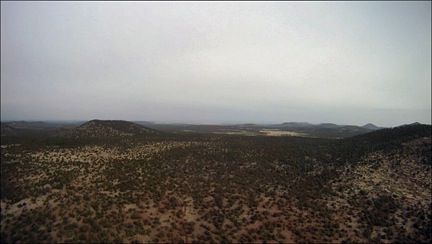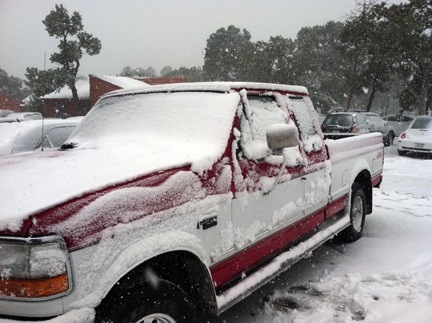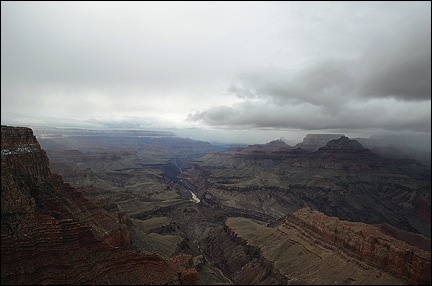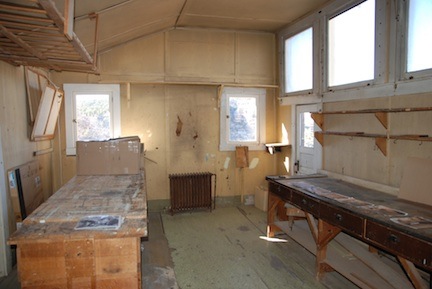A parting shot.
This short, unedited video clip was taken during departure from Marble Canyon Airport at the base of the Vermilion Cliffs in northern Arizona not long after sunrise.

A parting shot.
This short, unedited video clip was taken during departure from Marble Canyon Airport at the base of the Vermilion Cliffs in northern Arizona not long after sunrise.
A quickie video.
A helicopter flight from Page, AZ to Marble Canyon, AZ revealed first light on the aptly named Vermilion Cliffs. Excellent footage of Marble Canyon and the historic Navajo Bridge. Shot with a GoPro Hero video camera mounted on a Robinson R44 Raven II helicopter.
Weather. Again.
This week, I’m on a Southwest Circle Helicopter Adventure with two very nice folks from California. Although this helicopter excursion normally runs 6 days and 5 nights, these folks expanded the trip to add 2 more days at Lake Powell.
The weather was an issue from Day 1, when we departed Phoenix Deer Valley Airport and headed north to Sedona. Although the forecast didn’t seem out of the ordinary — mild temperatures, light winds, clear skies — an odd white haze had settled over the Phoenix area, making visibility poor. It was like flying in Los Angeles. Ick.
 So instead of giving my guests their Phoenix Tour and heading up the Verde River on Day 1, we took a shorter route to Sedona that overflew Lake Pleasant and stayed within several miles of the I-17 corridor. I figured I’d save the scenic flight for when visibility was better. I also expected visibility to be better in the Sedona area and was very surprised that it was not.
So instead of giving my guests their Phoenix Tour and heading up the Verde River on Day 1, we took a shorter route to Sedona that overflew Lake Pleasant and stayed within several miles of the I-17 corridor. I figured I’d save the scenic flight for when visibility was better. I also expected visibility to be better in the Sedona area and was very surprised that it was not.
Of course, I watch the weather closely on these trips. Heck, I seldom go for more than a few hours without checking the forecast for the next three days and destinations. That’s how I knew the wind would kick up at the Grand Canyon for Day 2 and likely keep blowing through Day 3.
 The flight to the Grand Canyon on Day 2 wasn’t anything special — except for that white haze that persisted, even up on the Coconino Plateau. Very odd for Arizona. It wasn’t blowing dust, either — the wind wasn’t strong enough for that. Just an ugly haze.
The flight to the Grand Canyon on Day 2 wasn’t anything special — except for that white haze that persisted, even up on the Coconino Plateau. Very odd for Arizona. It wasn’t blowing dust, either — the wind wasn’t strong enough for that. Just an ugly haze.
We got to the Grand Canyon in time for my guests’ helicopter tour with Maverick Helicopters. We then piled into my redneck truck, which lives at the Grand Canyon during the winter months, and went into the park. I set my guests free to enjoy their day at the South Rim and did my job: getting their luggage into their rooms. Then I relaxed in my own room. I’d been at the Grand Canyon so many times when the weather was so much better. I was tired and thought I’d take it easy for the rest of the day.
Of course, I still watched the weather. I wasn’t happy about what I saw for Day 3. Winds 25 gusting as high as 41 would make for a rough flight out of the area. And then there was the 90% chance of precipitation with 100% sky cover. The forecasters said to expect snow flurries with accumulations under 1 inch. This was a far call from the blizzard I’d experienced at Bryce Canyon the month before, so the snow didn’t worry me much. It was the cloud cover. I knew how low clouds could get at Grand Canyon Airport. If they came too low for a safe, VFR departure, we’d be stuck.
One of the drawbacks to scheduling a Southwest Circle excursion is that everything needs to be booked and paid for in advance. Last minute cancellations are not only costly, but they cause nightmares in merely making changes. For example, if we missed a Monument Valley date, we would likely not be able to stay there the next night — the place is booked months in advance. My guests were scheduled to take an Antelope Canyon Tour on Day 3 and a Lake Powell boat ride to Rainbow Bridge on Day 4. Although Antelope Canyon could likely be rescheduled, the boat trip could not. So weather delays cause nightmares for me during a trip. It’s for that reason that I usually can’t relax until we reach Monument Valley, normally on Day 4.
 Day 3 dawned gray but with plenty of visibility. I even got out and snapped a few photos when the sun poked through some clouds and illuminated one of the rock formations in the canyon near Bright Angel Lodge, where we were staying. I grabbed some coffee, went back to my room, and checked e-mail. An hour later, I peeked out the window and saw that it was snowing.
Day 3 dawned gray but with plenty of visibility. I even got out and snapped a few photos when the sun poked through some clouds and illuminated one of the rock formations in the canyon near Bright Angel Lodge, where we were staying. I grabbed some coffee, went back to my room, and checked e-mail. An hour later, I peeked out the window and saw that it was snowing.
It was 7 AM. We were scheduled to leave at 9 AM.
Over the next hour, visibility dropped to near zero and the snow came down hard and fast.
After dealing with an almost flat tire on my redneck truck, I called my guests and told them we’d be delaying departure. I got their room checkout time extended to noon.
By 9 AM, it was pretty obvious that we weren’t going anywhere anytime soon. I shot this video outside the Bright Angel Lodge, right on the rim of the canyon. (I added the voiceover later that night.) Trouble was, I couldn’t extend our stay at the Canyon and I had all those other activities scheduled.
 I felt bad for my guests. They’d spent a lot of money on this trip and now they were stuck at a scenic place with no scenery and no helicopter flight to get them to their next destination. So I became their driver for the day. After realizing that the truck was not likely to make it to Desert View (on the east end of the park) before the roads were cleared, we stopped at the Visitor Center and the Geology Museum before heading into Tusayan (the tourist town outside the park) for lunch. The plan was for them to see the IMAX movie across the street next.
I felt bad for my guests. They’d spent a lot of money on this trip and now they were stuck at a scenic place with no scenery and no helicopter flight to get them to their next destination. So I became their driver for the day. After realizing that the truck was not likely to make it to Desert View (on the east end of the park) before the roads were cleared, we stopped at the Visitor Center and the Geology Museum before heading into Tusayan (the tourist town outside the park) for lunch. The plan was for them to see the IMAX movie across the street next.
By 1 PM, the weather seemed to be clearing out. As we ate lunch at a “steakhouse,” I came up with a plan. While they were watching the movie, I’d prep the helicopter for departure. If the visibility held, we could escape to the east and arrive in Page before dark. (I’d already rescheduled their Antelope Canyon tour for Day 5.)
 But that plan failed miserably. When I got to the airport, I found the helicopter’s right side — the side facing the weather — completely iced over. The main rotor hub, the tail cone, and the tail rotor were all coated with ice. Even the skids looked frozen to the ground. And, of course, there was a good helping of snow in the fan scroll (again!) and even some inside the air intake port. The temperature had dropped by 10°F and it was now below freezing. It would not warm up again that day. The helicopter was officially grounded.
But that plan failed miserably. When I got to the airport, I found the helicopter’s right side — the side facing the weather — completely iced over. The main rotor hub, the tail cone, and the tail rotor were all coated with ice. Even the skids looked frozen to the ground. And, of course, there was a good helping of snow in the fan scroll (again!) and even some inside the air intake port. The temperature had dropped by 10°F and it was now below freezing. It would not warm up again that day. The helicopter was officially grounded.
 I wound up driving them to Page. The trip should have taken just over 2 hours, but since the weather was clearing enough to see into the canyon, we made several stops along the way. We arrived in Page at 8 PM. I checked them into their room, made sure they were set for the next day’s boat ride, and checked into my room at the Day’s Inn.
I wound up driving them to Page. The trip should have taken just over 2 hours, but since the weather was clearing enough to see into the canyon, we made several stops along the way. We arrived in Page at 8 PM. I checked them into their room, made sure they were set for the next day’s boat ride, and checked into my room at the Day’s Inn.
 Now what I needed was a thaw — temperatures above 32°F. I must have called the AWOS number for GCN a dozen times before 10:30 AM on Day 4. Then I climbed into my redneck truck and made the trek down to Grand Canyon Airport. It took 2 and a half hours with just one stop to snap pictures of a very different (from the previous day) view.
Now what I needed was a thaw — temperatures above 32°F. I must have called the AWOS number for GCN a dozen times before 10:30 AM on Day 4. Then I climbed into my redneck truck and made the trek down to Grand Canyon Airport. It took 2 and a half hours with just one stop to snap pictures of a very different (from the previous day) view.
The temperature was about 36°F when I arrived at the airport. The sun — my friend! — was playing hide and seek with thick, layered clouds. But the tour operators were all flying — visibility was great! Even the wind was not a factor. Most of the ice on the outside of the helicopter had melted. I just had to resort to my hot water trick to melt all the snow out of the fan scroll. After a good preflight, I started it up. A little rough at first and it took a full 10 minutes to warm up. But then I was ready to go and, after getting clearance from Grand Canyon tower, took off and headed east.
 The flight was, for the most part, smooth. I ran the video camera (as you might expect) and captured some good footage over the Little Colorado River Gorge and along the Echo Cliffs. I set down on a helipad at Page Municipal Airport at 3 PM.
The flight was, for the most part, smooth. I ran the video camera (as you might expect) and captured some good footage over the Little Colorado River Gorge and along the Echo Cliffs. I set down on a helipad at Page Municipal Airport at 3 PM.
Today, the weather is clear with not a cloud in the sky. My guests are just finishing up their Antelope Canyon Tour. Tomorrow, we’ll continue on our way, winding up at Monument Valley in the early afternoon. So far, the forecast looks great.
Let’s hope it stays that way.
Wild horses, antelope, and sheep — oh, my!
I flew from Grand Canyon Airport to Page Municipal Airport (at Lake Powell) again yesterday.
 Each time I make this trip, I follow pretty much the same route, hugging the southeast corner of the Grand Canyon Special Flight Rules Area (SFRA) until I get to the Little Colorado River Gorge and then heading pretty much due north. I wind up just outside the SFRA near Marble Canyon so I can show off Navajo Bridge and Lees Ferry before a quick flight past Horseshoe Bend, the Glen Canyon Dam, and Wahweap Marina. If the wind is in my favor, I can touch down at Page within an hour of departure from Grand Canyon. The same distance by car would take about 2-1/2 to 3 hours.
Each time I make this trip, I follow pretty much the same route, hugging the southeast corner of the Grand Canyon Special Flight Rules Area (SFRA) until I get to the Little Colorado River Gorge and then heading pretty much due north. I wind up just outside the SFRA near Marble Canyon so I can show off Navajo Bridge and Lees Ferry before a quick flight past Horseshoe Bend, the Glen Canyon Dam, and Wahweap Marina. If the wind is in my favor, I can touch down at Page within an hour of departure from Grand Canyon. The same distance by car would take about 2-1/2 to 3 hours.
The terrain for most of this flight — from the Little Colorado River Gorge north, in fact — is high desert — technically the famous “Painted Desert” — and relatively barren. There are, however, some interesting features if you look hard for them. Since I’m always trying to point out interesting things for my passengers to see, I look very hard.
Ruins are relatively common. Round rock foundations are the remains of ancient hogans. (This area is on the Navajo reservation.) There are also the remains of animal enclosures, usually build with the same rock. There are complete hogans, some of which may still be occupied for at least part of the year, and ranches with hogans, sheds, outhouses, animal enclosures, and other buildings. All of these things are scattered across an immense landscape that takes more than 30 minutes to cross at 120 miles per hour.
There are also animals.
One of the questions I’m asked quite often by passengers is whether I see wildlife from the helicopter. I do, but not so often as to make it a common occurrence. It depends on where I’m flying, what time of day it is, and how hard I’m looking for wildlife.
Take antelope, for example. There are a few “prairies” north of I-40 and west of Mt. Kendricks in northern Arizona where, if I look hard enough, I can usually spot a herd of antelope. I know where to look and I remember to look. They’re hard to spot because their color matches the terrain so well. It usually takes movement to spot them. When I see them and point them out, my passengers never see them at first. I have to slow down, turn around, and drop a few hundred feet as we approach the herd. That gets them running a bit so my passengers can see them. As soon as they’re spotted — and photographed, if the passengers remember to whip out a camera — I move away. It’s not my goal to terrify the antelope population of northern arizona by buzzing them with a helicopter.
(When I flew at the Grand Canyon, I always saw at least one elk a day in the forest on one of my first or last flights for the day. My passengers never saw them and, since swooping around to show them wasn’t possible, I simply stopped pointing them out. It would be my own private treat.)
There are wild horses in numerous places throughout Arizona. I wrote a bit about them here. They’re also on the route I take from the Grand Canyon to Page. Today, my passengers and I spotted at least four herds of them — the most ever. They’re a lot easier to spot than antelope because of their size and color. But they’re also a lot easier to confuse with cattle. I look for long legs and long, thick tails.
There are domesticated sheep in various places throughout northern Arizona. We flew over a good-sized herd tended by four dogs today. They were a lot farther south than I expected — I usually see them farther north. This could be a different herd, of course. There were about 50 animals in that herd and the dogs did a pretty good job of keeping them together, even when my helicopter spooked them. (Yes, I had to do a circle for my passengers to see them; they were pretty small.)
In the past, I’ve also seen javelinas (pronounced have-a-leenas) from the air. They’re usually in herds of a dozen or more animals and I’ve only spotted them when I was alone, flying a lot lower than I do with passengers on board.
Of course, I don’t have photos of any of this. I’m flying and my hands are usually busy. My passengers never seem to remember to send me their shots. But one of these days, I’ll have some photos to share.
I tag along on a mystery tour — of the Kolb Studio living quarters.

The public entrance to Kolb Studio, which clings to the rim of the Grand Canyon.
If there’s any such thing as “luck” I think it has to do with being at the right place at the right time. People who are truly lucky can recognize such an alignment and take advantage of it.
Like I did yesterday.
I was in the Kolb Studio at Grand Canyon Village. The Kolb Brothers were the original photographers of the Grand Canyon. They shot more images of tourism at the South Rim — there are 60,000 negatives in the archives — than anyone else. They also made a movie of their boat trip down the Colorado River through the Canyon and it played daily at their studio for over 45 years, making it the longest running movie in the world. That’s what the Ranger told us, anyway.
Today, the Kolb Studio is known primarily as a bookstore and art gallery. The old movie screening room which is on the second level down, has been converted into a gallery. Last time I was at the Canyon, the gallery was closed for some reason. This time, when I stood at the top of the steps to look down into it, I saw that they were packing up artwork to ship it back to the artists.
But as I stood on that upper landing, a young, thin, female ranger walked by, followed, like a mother duck, by a long string of tourists. There must have been about 15 of them. They were walking purposely down the stairs, past the barrier that had been erected to keep people out. I asked one of the last people, “Is this a tour?”
“Yes. Go to the desk to see if you can join us.”
I knew that if I went to the desk, even if they said yes, I’d be too late. So I just followed them.
Mind you, I had no idea what the tour was about. I had time to kill and it was clear that these people were going someplace I’d never been before. I wanted to go with them.

The sitting room in the living quarters at Kolb Studio. Beyond this is a “sunroom” with windows looking over the canyon.
I’d hit the jackpot. It turned out to be a tour of the Kolb Studios living quarters — the home of the Kolb Brothers.
Emory and Elsworth Kolb were given a piece of land at the edge of the canyon by Ralph Cameron who owned Bright Angel Trail and a bunch of other land on the rim. This was back in the early 1900s and Bright Angel Trail was a toll road. The Kolbs were given the land with the stipulation that they were to collect the tolls when Cameron wasn’t around. The Kolb brothers built their studio — first a tent, then a wooden frame building — on the edge of the cliff. A window on the building looked out over the start of the trail. The Kolbs would snap photos of the groups of mule riders going down. Then one of them would run all the way down to Indian Gardens, which is 4-1/2 trail miles and 3,000 feet down, where there was water. He’d develop the glass plates, make prints, and run all the way back up to the studio. When the riders returned, the photos were ready for purchase.

Inside the actual photo studio. The window on right right is the one they took photos of mule riders through.
There’s a lot more history to the Kolb brothers, but I’m not about to retell it here. Check out the PBS documentary about them or look them up in Wikipedia to learn more.
The more interesting thing is the house. It was built with its top floor level with the canyon rim. Subsequent floors were added below that. So the house literally clings to the side of the cliff. And it looks as if it were built over time by people who cared more about functionality than architecture.

The dining room at the Kolb Studio living quarters. Those windows look right out over the Grand Canyon.
But inside — wow. A perfect example of early 1900 homebuilding. The house I grew up in was built in 1901, so I know the style. Plaster walls, wood floors, molding. And all the windows looked right into the Grand Canyon.
The ranger led us though about a dozen rooms, including the sun porch, sitting room, kitchen, bedrooms, dining room, and, of course, studio and darkroom. (The darkroom was added after water became available at the Rim.) We were invited to take photos — even through the window the Kolb Brothers had used all those years ago. It was fascinating and a real treat for me.

The kitchen at Kolb Studio.
Let’s face it: I come to the Grand Canyon at least two dozen times a year. I’ve seen all the usual things. I’ve taken photos from the rim trail and every single rest stop or parking area on the rim. I’ve visited all the shops and eaten in all the restaurants and stayed in all of the hotels. I’m at the point where I’m almost bored when I come here. Almost.
When I finished the tour, the first thing I did was call Mike to tell him. I think he was jealous. Heck, I’d be if he’d gone without me!